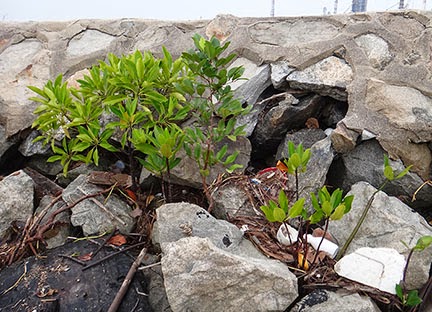More mangrove saplings have settled naturally on the other side of the artificial seawalls of Pulau Hantu!
A small team checked out the shores in very hazy conditions and found lots of interesting marine life.
Hazel who is studying marine life that settle on our artificial shores, pointed out the profusion of mangrove seedlings that have taken root on this seawall.
A large tree on the high shore nearby, however, seems to have totally died.
Some saplings at various stages of growth.
Some of the saplings have grown quite well.
One had grow into a large tree! It looks like a Mangrove cannon-ball tree.
The saplings grow where the seawall has started to break up.
But saplings also settled on unbroken seawall among the crevices.
Today, we were so excited to show Mei Lin the Fluted giant clams that we have started to spot at Pulau Hantu recently. Mei Lin studies these clams and is working on repopulating our shores with them. Alas, the first one we showed her had died! It is quite large too! We just saw it in Aug 2014 and it was alive. Oh dear.
Fortunately, Kok Sheng show us another Fluted giant clam nearby that was still alive. Mei Lin pointed out the white shell edges, which shows that the clam is growing well too.
We also check for coral bleaching (What is coral bleaching and why this is of concern on the Bleach Watch Singapore blog.) I saw this large colony of Anemone coral which looked rather yellowish and 'bleachy'. But most of the corals I saw seemed alright.
The Circular mushroom coral and Tongue mushroom coral I saw were not bleaching.
I was relieved to see that corals susceptible to bleaching were alright today. Such as Cauliflower corals and Crinkled sandpaper coral.
Other commonly seen corals were also doing alright.
The Asparagus flowery soft corals and Spiky flowery soft corals I saw today were not bleaching.
There are many large leathery soft corals and they were all doing fine.
Mei Lin spotted a Fire anemone, the first time I've seen one at Pulau Hantu. I also saw the Magnificent anemone and many Giant carpet anemones. Some had anemonefish in them, but the fishes were too shy for a photograph.
There are also many colourful sponges on the shores. This pink fluffy ball is just the tiny tip of a large buried sponge! Behind it is a nice Black bath sponge.
Wow, a giant cuttlebone! The original cuttlefish it belonged to must have been huge! Indeed, the Hantu Bloggers who regularly conduct guided dives at the reefs of Pulau Hantu sometimes come across enormous cuttlefish!
The mangrove trees that had settled on the artificial seawalls on other side of the lagoon are still doing well. And the Tape seagrasses here are also doing well.
Alas, I also saw many patches of Tape seagrasses that were cropped short. Similar to what we saw at Pulau Semakau two days ago.
I noticed, some Tape seagrasses had large brown rotting patches near the base of the plant. Is this the beginning of a 'cropped' Tape seagrass blade? What is causing it? How can we stop it? I don't have the answers but I hope the scientists are working on it.
A pair of large black herons were foraging on Pulau Hantu, just opposite the huge oil storage tanks being built on Pulau Busing next to Pulau Bukom. Among the exciting sightings by the rest of the team was a large sea turtle!
There was some flaring at the petrochemical plants on Pulau Bukom just across from Pulau Hantu.
When the tide went out, the people who were fishing on the jetty came to the shore to forage. I said hello and asked what they were collecting and had a look at the contents of their plastic bag. It was mostly Gong-gong snails which they said they were going to eat. Fortunately, we didn't come across a long net like we did in May 2014.
We left in very hazy conditions. Here are some large vessels near the orange Cyrene beacon, fading away into the haze. Haze hurts not just people, but also affects marine life. Here's a scientific paper by Dr Zeehan Jaafar and Dr Loh Tse-Lynn on the impacts.
This is the last of our surveys for October. Tonight, we end off the first evening low spring tides of the year with a training field trip with the volunteer guides of the Sisters Islands Marine Park.
Posts by others on this trip


























